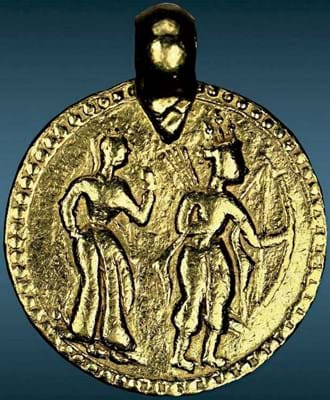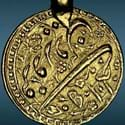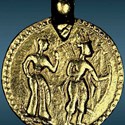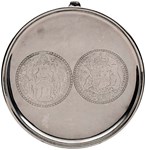The gold half mohur struck with a unique blend of Hindu and Islamic symbols during the reign of Akbar the Great (1542-1605) is perhaps one of only two known.
Walker’s auction house in Ottawa, Ontario, received the charm bracelet with a typical array of more than two dozen gold miniatures in summer 2019 but deemed the coin worthy of further research.
To one side were depictions of the Hindu deities Prince Rama and his wife Sita. To the other was an Islamic inscription with the Ilahi year 50 (1604-05) and the first month in the Persian solar calendar, Farvardin.
Jalal al-Din Muhammad Akbar (the third Mughal emperor ruling over a multicultural realm that tripled in size) is famous for attempting to forge a peaceful coexistence between his own Muslim faith and Hinduism.
Disillusioned with orthodox Islam, he adopted a policy of religious toleration – taking a Rajput princess as his bride, repealing the jizya (a tax paid by non-Muslims), ordering the translation of the Hindu epics into Persian and issuing a new coinage that opened a fresh chapter in India’s numismatic history. Propounding a syncretic religious movement called the Din-i-ilahi, a new calendar (the Ilahi dating system) was adopted taking Akbar’s accession to the throne in 1556 as the year zero.
On his death the system came to an end with some emblems of his reign destroyed by Akbar’s successors.
The Rama-Sita coin, that violated Islam’s general prohibition on the portrayal of people or objects that might be venerated, was among them.
The recent discovery, with a later gold hoop mount, was sent to the Numismatic Guaranty Corp of Florida where its authenticity was established.
It was compared with the specimen pictured in Friedberg’s Gold Coins of the World and the three known silver versions of the coin (one of them sold for $140,000 by Classical Numismatic Group in New York in 2010). All are thought to have been struck in Agra in the final year of Akbar’s 49-year reign.
On December 11 bidding for the new discovery began at $75,000 and rose in $25,000 increments for close to four minutes until the gavel fell at Can$420,000 plus 20% buyer’s premium.
The bracelet, given to the vendor by his great grandmother, sold for an extra Can$8000 ($4700).


















